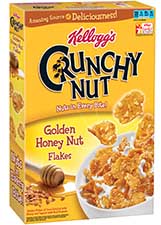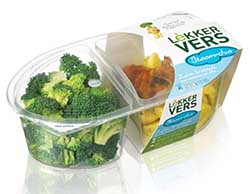More Trailblazing Innovation for Food Packaging Systems
PACKAGING
Continuing on the path of critical enumeration of food packaging innovation destined to materially change systems and structures during the coming decades, the packaging industry plunges into the future. Last month, I discussed electronic inks, graphene nano coatings, naturally derived anti-microbial coatings, and sensors for ripeness and spoilage. Before addressing the exploding realm of controlled atmosphere packaging in the January 2014 column, I must suggest that non-traditional sources (i.e., consumer packagers, packaging converters, and package materials makers) are no longer the sole providers of entities that will be de rigueur by decade’s end. Science-based academic institutions, electronic and computer organizations, remote consultancies, and daring inventors from afar are now penetrating the once passive universe of food preservation and protection with dramatically intelligent activity-based concepts.
Interaction with Mobile Devices
Is there a contemporary high school or college student absent of the ubiquitous smartphone that does everything short of manufacturing food on demand from electrons and protons, or a laptop linked directly to each class and extracurricular adventure? Are there any adults who do not overtly or surreptitiously connect through these tchotchkes with their children, grandchildren, brokers, or health professionals to visit, learn, or expound? Already, devices that scan on-package codes are being used in supermarkets to obviate any need for checkout; they are highly effective: Consumers scan and place packaged foods in their shopping carts, and their bank accounts are debited with the purchase price read from the UPCs on products. There is no need to stand in line for checkout. Convenience for purchasers begins at the retail shelf—especially for those who believe that shopping is a nuisance.
 Label-maker Avery Dennison Corp. (www.averydennison.com) offers Direct Link™ labeling products that can be scanned using smartphones utilizing radio-frequency identification (RFID) and near field communication (NFC). Once scanned, these labels immediately send information about the packaged product—price, nutritional value, preparation instructions, etc.—to a consumer’s smartphone. To relieve the boredom of shopping, Finland’s WiPak (www.wipak.com) offers Self Talk and other electronically driven on-package codes that can deliver sounds (e.g., music) to entertain consumers during and following the store experience. And some select Kellogg’s (www.kelloggs.com) packages are marked with QR codes to convey music to wandering consumers’ smartphones.
Label-maker Avery Dennison Corp. (www.averydennison.com) offers Direct Link™ labeling products that can be scanned using smartphones utilizing radio-frequency identification (RFID) and near field communication (NFC). Once scanned, these labels immediately send information about the packaged product—price, nutritional value, preparation instructions, etc.—to a consumer’s smartphone. To relieve the boredom of shopping, Finland’s WiPak (www.wipak.com) offers Self Talk and other electronically driven on-package codes that can deliver sounds (e.g., music) to entertain consumers during and following the store experience. And some select Kellogg’s (www.kelloggs.com) packages are marked with QR codes to convey music to wandering consumers’ smartphones.
For wine aficionados in the beverage aisle, a new label system can provide the all-important authentication information. By downloading an appropriate app, wine experts can tap a bottle’s NFC label and immediately receive key information such as serial number, type, grape variety, vintage, and vineyard as well as price, sales promotions, marketing hyperbole, etc.
More recently, Kezzler (www.kezzler.com) has introduced a readable package label-driven algorithm that is capable of authenticating the package and its contents. Instead of reading and confirming the actual label code, the signal triggers a program that performs the actual authentication. Food fraud is increasingly an issue in industrialized food systems, so verification of the product/package integer is becoming more important to distributors and consumers.
Ripeness and More Indicators
Futuba Electronics (www.futuba-rc.com) offers RFID-transmitted fruit quality detector-signalers. Passive ultra-high frequency tags that monitor the environment for temperature and relative humidity are embedded in the plastic structure of injection molded returnable reusable crates of pears, grapes, oranges, mangos, etc. The transmitted information directs a distributor to release a product or retain it for further ripening. This type of system has been quietly deployed in New Zealand to control distribution of fresh red meat in both primal cut and final packaged retail cut forms in a centralized fresh meat operation serving about 135 retail stores.
The RFID tag is embedded in the internal transport crates moving bulk meat under modified atmosphere from the kill floor to breaking, cutting, and grinding. During the transfer of packaged retail cuts into RFID-equipped crates for distribution to retail stores, time-temperature data are monitored and signaled throughout the distribution system. This is a major and very effective commercial application of coupling temperature-time integration with RFID technology for food other than produce. The entire system beginning with the kill floor and ending in the almost robotic dispensing of the individual packages of fresh red meat to the display is a demonstration of the ability of intelligently engineered active and intelligent packaging to extend the shelf life of perishable foods.
Deterioration Signals
Amidst all the public discussion on expiration dates as indicators of quality and safety, a number of new spoilage sensors have emerged. A nanosignaler created by scientists at Massachusetts Institute of Technology and Rice University senses and signals food deterioration via a photonic gel self-assembly from long polymers that are layered onto polystyrene and P2VP. When ions of biochemical spoilage are exposed in hydrophobic layers in very high surface area package materials, a color change occurs. Insignia Technology Services (www.insigniatechnology.com) is offering a plastic package structure adjunct that detects the presence of excess carbon dioxide by changing color.
From Wageningen University in the Netherlands comes a sea-food spoilage detector that can link to a mobile device. The sensor applies an ammonium electrode, a pH electrode, or a conductivity electrode to detect volatile amines and sulfides that are the end-products of seafood protein degradation. The signals are integrated with algorithms to predict the microbiological quality of seafood (or meat or poultry) so that members of distribution channels can anticipate accelerating movement or arriving at end of shelf life. The detection indications are transmitted through RFID devices.
--- PAGE BREAK ---
Controlled Respiration
The concept of altering the environment surrounding fresh and minimally processed food products such as vegetables and fruit will be discussed in detail in the January 2014 column, but fresh foods continue to respire after harvest, and microorganisms present on produce continue to grow, consuming oxygen and producing carbon dioxide. Deterioration rates can be significantly reduced by decreasing oxygen concentration and, hence, respiration rate. Simultaneously, elevation of carbon dioxide suppresses growth rate of aerobic microorganisms that are partially responsible for spoilage and loss of quality. Unfortunately, reducing the level of oxygen to near zero in the environment of respiring produce can lead to respiratory anaerobiosis, during which a totally different biochemical route occurs, leading to the production of aldehydes, ketones, alcohols, etc., which are deteriorative. To mitigate adverse anaerobic respiratory respiration, oxygen is usually admitted at low levels to the produce environment while applying one or more of several different mechanisms. The most obvious is to employ a highly gas-permeable package material either as the total package structure or as a patch applied to the surface. Another method is to puncture the package, which can be accomplished in a macro fashion, which eliminates the atmospheric control, or a micro perforation technology, which can optimize the atmosphere.
In commercial practice today, the fresh produce package material is laser micro-perforated to a universal gas transmission that is satisfactory but usually not optimum for any specific produce content. To address the issue of maximizing shelf life, PerfoTec (www.perfotec.com), a Dutch consortium, has introduced technology that measures the rate of respiration of fresh produce to be packaged, computes the required optimum package gas permeability, and performs laser microperforation immediately before the actual packaging operation. The technology verifies the openings by camera, customizing the gas permeation rate of the individual packages and extending the chilled shelf life by approximately 50% over air packed. DSM (www.dsm.com) has filed a patent application for controlled water vapor/oxygen/carbon dioxide permeability plastic applied as a patch on package surfaces. This eliminates water drop condensation on the package interior, thus increasing the visibility of package contents.
Global Fresh Technology Group is reporting on the effects of ethylene (a produce respiratory gas) on the shelf life of fresh fruit and vegetables. When the ethylene concentration in the environment is reduced to 100 parts per billion, significant increases in shelf life are achieved. Some Japanese sources are offering package materials embedded with platinum nanoparticles on meso-porous silica to remove ethylene in synergy with macro removal of atmospheric ethylene.
 Dutch prepared-food company CH Food (www.chfood.nl) is introducing a smart package called Variable Heating Steaming. The meat and vegetable combination is modified atmosphere packaged in a compartmentalized microwaveable polypropylene tray sealed with polyethylene film. The lidding film is laser microperforated in two areas: one is the vegetable component to optimize chilled shelf life; the other is over the meat component. Pressure-sensitive labels capable of opening to vent microwave generated steam are applied over the microperforations. The microperforation patterns are said to permit the meat component to cook for longer periods than the vegetable portions, thus optimizing the re-thermalization process.
Dutch prepared-food company CH Food (www.chfood.nl) is introducing a smart package called Variable Heating Steaming. The meat and vegetable combination is modified atmosphere packaged in a compartmentalized microwaveable polypropylene tray sealed with polyethylene film. The lidding film is laser microperforated in two areas: one is the vegetable component to optimize chilled shelf life; the other is over the meat component. Pressure-sensitive labels capable of opening to vent microwave generated steam are applied over the microperforations. The microperforation patterns are said to permit the meat component to cook for longer periods than the vegetable portions, thus optimizing the re-thermalization process.
Future Active and Intelligent Food Packaging
Clearly evident from this recitation of select current and near future active and intelligent packaging is that soon food packaging will be greatly altered by applications. It’s hard not to envision rapid acceptance since too many interactions with distribution channels, consumers, quality, appliances, and disposition are available; these advances will benefit the food industry. Minimization of pathogenic issues and food waste as well as optimization of consumer experiences will all result from implementation of these technologies. Some might even ask, “What took you so long?”
 Aaron L. Brody, Ph.D., CFS, Contributing Editor
Aaron L. Brody, Ph.D., CFS, Contributing Editor
President and CEO,
Packaging/Brody Inc., Duluth, Ga.,
and Adjunct Professor, University of Georgia
[email protected]
